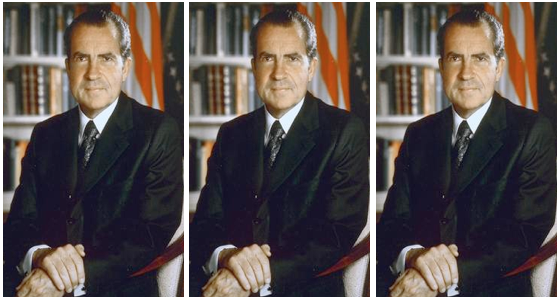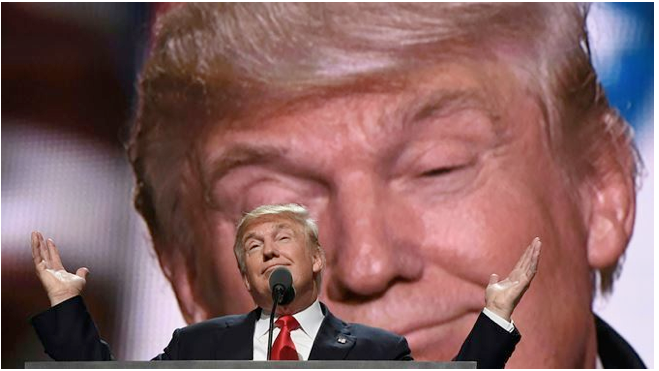Dear So-Called President Trump: Where’s My Protest Paycheck?
THE PROTEST ECONOMY-Dear So-Called President Trump: I was among the roughly five million Americans who took to the streets in cities across the country a few weeks ago in opposition to your outrageous policies regarding women, Muslims, school children, immigrants, workers, the environment, and people who need health care. (That’s me in the photo above with my 20-year old daughter Sarah.) I left my home around 7 a.m., took the subway from Pasadena to downtown Los Angeles, and participated in the demonstration -- marching, holding signs, shouting chants, listening to speakers and musicians -- until about 4 p.m. I got back on the subway and returned to my house around 5 p.m. In other words, I spent about 10 hours involved in the protest.
That was the largest one-day protest in American history. A majority of the five million participants (750,000 in LA alone) were protesting for the first time. I didn’t really understand what brought them out to protest on a sunny Saturday when they could have been doing so many other things. But your recent Tweet explained why.
Last week you Tweeted that “Professional anarchists, thugs and paid protesters are proving the point of the millions of people who voted to MAKE AMERICA GREAT AGAIN!”

Thank you for the reminder. I forgot to pick up my paycheck for protesting. Whomever is paying people to protest left me off the list -- or just ripped me off. Since the federal minimum wage is $7.25 an hour, I am owed at least $72.50 for the 10 hours I spent protesting that Saturday. However, as of this January 1, the California minimum wage is now $10.50 an hour, so I’m actually owed $105, and even more if the people who are paying people to protest against you abide by overtime rules.
 If all five million Americans who protested that day got paid the federal minimum wage, and if people spent an average of five hours protesting, those patriotic rabble-rousers are owed a total of at least $181 million in unpaid protest wages.
If all five million Americans who protested that day got paid the federal minimum wage, and if people spent an average of five hours protesting, those patriotic rabble-rousers are owed a total of at least $181 million in unpaid protest wages.
I think you’ll agree that putting $181 million in Americans’ pockets is good for the economy. If you will recall the Economics 101 course you probably took at college, this is called an increase in “consumer demand.” Economists also call it the “multiplier effect.” The five million protesters will spend that $181 million in their local economies -- boosting sales, revenues, and jobs. So thank you for reminding us that protest is good for the economy.
You will be pleased to know that Americans will continue to protest your policies for the next four years. Not all the protests will be as large as the January 21 women’s march, but the number of Americans who feel compelled to protest against you will certainly grow as you pursue reckless, dangerous and inhumane policies. Every week, in cities, suburbs and small towns across America, people will be in the streets, at town meetings, on college campuses, at their workplaces, at airports, in churches and synagogues, and elsewhere raising their voices in opposition to almost everything you are trying to do.
Let’s take a conservative estimate that every week, on average, 100,000 Americans engage in some kind of local protest over the next four years. Let’s assume that each person spends an average of three hours participating in protest and earns the current federal minimum wage of $7.25 an hour. That adds up to $452 million during your four years as president -- assuming you are not impeached.
Of course, you won’t be surprised that in addition to all those local protests, at least four times a year, Americans will mount the kind of major nationwide protests that we saw a few weeks ago, with five million people taking to the streets. So let’s add another $181 million for each protest -- four times a year, for four years. This will increase the protest payroll by another $2.9 billion. Altogether, that’s $3.42 billion in protest paychecks over four years. I haven’t even factored in the higher minimum wage levels in many states and cities.
You are already doing your part by adopting policies and making statements that make Americans so angry that they are joining protests in record numbers. But if you’d really like to do something to improve the economy even more, you could raise the federal minimum to $15 an hour. That would quickly and dramatically increase America’s protest payroll and be a real boost the economy.
I realize that it is selfish of me to bring this up, but what about all the back pay I’m owed for the protests I’ve participated in since the 1960s? I’ve been to hundreds of protests for civil rights, against the Vietnam war, for women’s rights and against apartheid, for more funding for public schools, against the U.S. overthrow of Chile’s president Salvador Allende and against U.S. aid to the Nicaraguan contras, against police killing of unarmed Black Americans, in favor of workers’ rights, and against government bail-outs to Wall Street banks.
As you can see in the above photographs, I brought my twin daughters Amelia and Sarah to a protest in Los Angeles in 2002 against the U.S. invasion of Iraq and I joined with my wife Terry, our dog Mia, and our friends last year at a huge march of workers and supporters demanding a $15 minimum wage in my hometown of Pasadena. (You’ll be please know that we won that fight). On a rainy night two weeks ago I joined about 150 people at a protest in front of the $26 million Los Angeles mansion owned by Steve Mnuchin, the Wall Street predator (known as the “foreclosure king”) who was your campaign finance chair and whom you’ve nominated to be Secretary of the Treasury. (That’s me, with the gray hair, behind the sign).
Shouldn’t the hundreds of millions of Americans who, over the years, sat in at lunch counters, participated in strikes, carried picket signs for reproductive rights and same-sex marriage, rallied against nuclear weapons, and shouted “no justice, no peace” and “end racism” get paid for their protest activism? Rep. John Lewis, who put his body on the line hundreds of times for social justice -- and whom you described as “all talk, no action” in a twitter tantrum last month -- would be owed a fortune in back protest pay.
Do you think we could find a “so-called” judge who would be sympathetic to this wage-theft cause and order the owners of Protest Inc. to compensate us for our labor?
I don’t consider this reparations for radicals and reformers. I see it as the kind of economic nationalism you’ve been talking about. You can’t export protest jobs. These are American jobs for Americans. As any economist could tell you, those back payments would do wonders for the economy.
Just as George W. Bush was known as the “war president,” and Barack Obama was known (at least by Republicans) as the “food stamp president,” you will surely go down in history as the “protest president.” You’ve done more than any other U.S. president to unite Americans and galvanize them into an oppositional protest movement. You’ve called us “paid protesters.” Once we all get paid, we will feel proud to have helped make America Great Again.
(Peter Dreier is E.P. Clapp Distinguished Professor of Politics, and chair of the Urban & Environmental Policy Department, at Occidental College.) Prepped for CityWatch by Linda Abrams.








 Yes, well. The media quickly agreed they had, in fact, failed to cover it because it had, in fact, never happened. Turns out Conway was evidently
Yes, well. The media quickly agreed they had, in fact, failed to cover it because it had, in fact, never happened. Turns out Conway was evidently 
 A
A 
 The Ferrari California aligns with the state on the level of metaphor. California is famously the “Great Exception” among American states, as the 20th century author Carey McWilliams named it, and California is an exception among Ferraris. But the nature of that exceptionalism might surprise you; California is not the most expensive or the most glamorous or the fastest Ferrari.
The Ferrari California aligns with the state on the level of metaphor. California is famously the “Great Exception” among American states, as the 20th century author Carey McWilliams named it, and California is an exception among Ferraris. But the nature of that exceptionalism might surprise you; California is not the most expensive or the most glamorous or the fastest Ferrari. 






 There are certain things that we accept as facts with no alternatives. The Earth is becoming warmer due to human action. The diversity of life arose by evolution. Politicians who devalue expertise risk making decisions that do not reflect reality and must be held accountable. An American government that ignores science to pursue ideological agendas endangers the world.
There are certain things that we accept as facts with no alternatives. The Earth is becoming warmer due to human action. The diversity of life arose by evolution. Politicians who devalue expertise risk making decisions that do not reflect reality and must be held accountable. An American government that ignores science to pursue ideological agendas endangers the world.



















